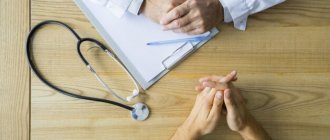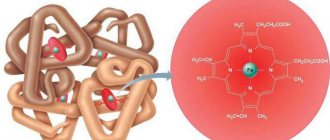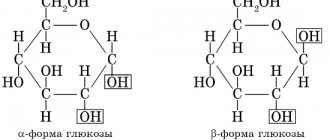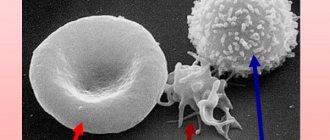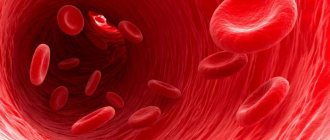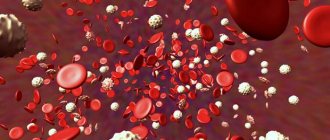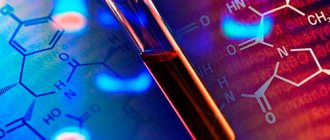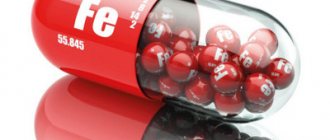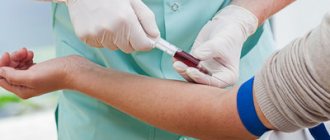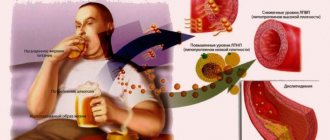TOP 10 products to increase hemoglobin
Very often, an unbalanced diet leads to a decrease in hemoglobin levels. Therefore, the easiest way, which is suitable both for prevention and for solving the problem, is to eat foods with a high iron content. Let's find out more about them.
- Protein products of animal origin contain a lot of iron, which is absorbed by our body by at least 20 percent. This is four times more than from vegetable protein! Therefore, be sure to include lean beef, veal, liver and beef tongue in your diet.
To avoid gaining excess weight, it is best to eat these foods boiled or baked.
- The second place is occupied by seafood and sea fish.
- Fatty fish contains not only beneficial iron, but also Omega-3 polyunsaturated fatty acids. They reduce inflammation and help the body recover faster.
- Seafood is low in calories and this is a plus for those watching their figure. There is approximately 30 ml of iron per 100 grams.
- I’ll also add seaweed here; 100 grams of kelp contain 16 mg of microelements. In addition, it contains a large number of other useful substances.
- Sesame seeds add a piquant taste to meat dishes, salads and baked goods. It is also an excellent source of iron. Of course, it is best to eat them raw, but even slightly dried, they will be beneficial. 100 grams of product contains 16 mg of trace elements.
- Next on the list is bran, with 15 mg of iron per 100 grams. They also contain B vitamins, which help produce hemoglobin. But you need to eat bran carefully; 20-30 grams per day will be quite enough. If you eat a little more, you may experience digestive problems.
It is tasty and healthy to mix bran with kefir or yogurt; one tablespoon per glass is enough.
- Lentils contain a lot of protein and iron, 100 grams - 11.8 mg. It also contains: vitamins A, E, PP, B vitamins, as well as tocopherol, thiamine and riboflavin.
- Buckwheat is an accessible source of microelements; 100 contains 8.3 mg. You can come up with a large number of interesting dishes from it: buckwheat cutlets, soup, side dish with mushrooms, etc.
- Hazelnuts, peanuts, almonds and pine nuts help maintain hemoglobin levels, but their health benefits are much greater. If you eat a small handful of nuts every day, it will have a positive effect on memory, skin beauty and immunity.
- Do you like to crack roasted sunflower seeds? I am very! But to get more iron, you need to eat them raw or slightly dried. 100 grams contain 6.1 mg of useful substance. It’s convenient that now you can find already peeled seeds in almost any supermarket.
- The yolk of a chicken egg also contains 100 g of iron - 6.7 mg, but you can eat no more than two eggs per day. A great option is to cook a light omelet with herbs in the morning, it’s both tasty and healthy!
- If you love flour, I advise you to give preference to baked goods made from rye, buckwheat and whole grain flour. Each of them contains iron and benefits digestion. The plus is that such products will not spoil your figure and you can stay in good shape!
What should you not do if your blood level is low?
Of course, iron foods should be included in your diet, especially if you have low hemoglobin levels. However, in some cases this may not be enough. Therefore, doctors prescribe taking iron supplements orally or by injection. Both options have their drawbacks.
- Many women complain that iron products cause side effects such as nausea, vomiting, constipation and diarrhea. They are as difficult to tolerate as symptoms of low hemoglobin.
- Injections are carried out only in the hospital, in some cases they can provoke an allergic reaction. This method is contraindicated for women in the first trimester of pregnancy.
Such drugs have high toxicity. Therefore, in both cases you need to strictly follow the instructions and not exceed the dosage, otherwise you risk getting the opposite result!
Nutrition rules
To increase the level of hemoglobin in the blood, an adult needs to change his diet. The largest number of substances necessary for the synthesis of hemoglobin is contained in the following products:
- beef;
- veal;
- mutton;
- pork liver;
- rabbit meat;
- turkey meat;
- chicken eggs;
- mussels;
- shrimps;
- mushrooms;
- beans;
- lentils.
The cooking process should be as fast as possible. It is better to do this either steamed or over high heat. Prolonged cooking should be avoided.
To normalize processes in the red bone marrow, you also need products with the maximum possible amount of vitamins (B6, B9, B12, C, E):
- legumes;
- fish;
- pomegranate;
- chicken's meat;
- Brewer's yeast;
- cheeses;
- citrus;
- horseradish;
- spinach;
- Bell pepper;
- dried apricots.
Expert commentary
Kardash Anton Borisovich
Therapist, cardiologist. Doctor of the highest category.
Before using traditional methods, you should consult a specialist. In most cases, home treatment is not enough to correct the pathological condition caused by a decrease in hemoglobin concentration in the blood. This is especially true for pregnant women and the elderly.
How to increase hemoglobin quickly and without consequences?
Today, carbonyl iron . It does not contain metal salts, which provoke unpleasant symptoms. Some people note that they feel better already on the second or third day of use, and without side effects. This is explained by the fact that this form of iron is well absorbed by the body and is completely non-toxic.
Carbonyl iron is part of natural supplements; BoostIron . At the Research Institute of Obstetrics and Gynecology named after. BEFORE. Otto (St. Petersburg), studies have been conducted in which this remedy has proven itself well. I would like to note that BoostIron was even included in health programs for pregnant women. Therefore, you can safely take this supplement in order to increase your hemoglobin levels!
What to pay attention to
In order for iron to be well absorbed, supplements should include vitamin B12, folic acid and vitamin C. The same goes for food. Be sure to add to your diet:
- Sweet bell pepper
- Kiwi
- Broccoli
- Oranges
- Watercress
- Rose hip
- Grapefruit
- Mango
- White cabbage
- Tomatoes
Find out the reason and solve the problem
A decrease in hemoglobin levels in the female body can be caused by various reasons. Therefore, it is not difficult to guess that if the main problem is solved, blood counts will gradually recover. Therefore, let's find out why hemoglobin may be low:
- Every month during menstruation we lose a certain amount of blood. As a rule, during this period of time, Hb (hemoglobin) levels are moderate and there is nothing to worry about. These are the characteristics of our body.
- Blood loss caused by abortion or miscarriage is more dangerous. Fortunately, doctors can easily identify these causes and provide the necessary assistance. The situation is much more serious with hidden bleeding, when an ulcer in the gastrointestinal tract or hemorrhoids is gradually being touched up. At first, the woman does not pay attention to the loss of strength, attributing everything to fatigue and overwork. Meanwhile, Hb levels gradually decrease.
- The next reason is an unbalanced diet. If the diet is low in foods containing iron, or vitamin B12, folic acid or vitamin C, which are necessary for its absorption, hemoglobin production is reduced.
- Parasites and worms feed on vitamins and iron-containing elements that are needed for the production of hemoglobin. Therefore, any parasitic infection increases the risk of this problem.
- There is an enzyme called hespedin, it regulates the level of iron in the plasma. Acute or chronic inflammatory process increases the amount of enzyme. This leads to impaired protein production and decreased iron.
- A decrease in hemoglobin may be associated with hypothyroidism. The thyroid gland produces thyroxine, this hormone helps the intestines absorb iron. It turns out that endocrine disease reduces the flow of microelements into the blood.
- Low hemoglobin levels are often observed in young girls during hormonal changes and in women during menopause.
What should I do?
In addition to taking special medications, it is recommended to eat a diet balanced in iron and nutrients. The menu is developed by a nutritionist and gastroenterologist.
Basic principles of nutrition
It is recommended to saturate the body of an elderly person with foods rich in iron.
The classification of iron depends on the valency and rate of absorption.
Table 4. What types of iron are there?
| Hemo iron | Non-hemo iron |
| Animal origin | Plant origin |
| Bivalent | Trivalent |
| Digestibility – 7-8% | Digestibility – 18% |
The menu is compiled depending on the stage of anemia. The nutritional instructions are as follows:
- Breakfast includes 2 dishes. It is recommended to eat boiled fish or liver. You can serve porridge or vegetable puree as a side dish. It is advisable to have breakfast no later than 09:00.
- Lunch starts at 12:00. You can eat stewed vegetables and fish. You should wash down your food with warm rosehip decoction.
- You should have lunch at 14:30-15:00. Serves 3 dishes: soup, main course and compote.
- The afternoon snack includes fresh berries, fruit jelly, and mousses. You can drink tea. It is advisable to sit down to have lunch no later than 17:00.
- Dinner includes 2 courses. One should consist of cereals, the second should consist of meat or fish. Vegetables must be present. You should sit down for dinner no later than 19:30.
Note! Food should not be cooked for long periods of time. Otherwise, iron oxidizes and becomes unsuitable for hemoglobin synthesis processes.
In addition to iron, an elderly person's diet should include foods rich in folic acid.
8 best products for normalizing hemoglobin
Products recommended for older people are presented on the plate.
Table 5. Superfoods that normalize hemoglobin.
| Product | Description |
Halva | It is a source of vitamins B, E and F, Ca, Zn. It is recommended to eat both sesame and sunflower halva. |
Meat fillet | Helps restore red blood cells in the blood and increase hemoglobin. Digestibility accounts for 20% of the total volume of food absorbed. In order to increase hemoglobin, 100 grams of meat fillet are required, to maintain it at normal levels - 50 grams. |
Seafood | The emphasis should be on eating shrimp, squid and oysters. |
Wheat bran bread | Contains B vitamins that synthesize iron-containing protein. The permissible daily intake is 100 grams. Overweight people can replace bread with 30 g of wheat bran. They can be added to porridge. |
Pictured is seaweed | Helps normalize the process of hematopoiesis, helps maintain the general condition of the body is normal. |
Beet | It is advisable to eat it boiled. Beetroot juice is also beneficial. |
Pomegranate | It is recommended to drink pomegranate juice. Persons with gastrointestinal problems should dilute it with water. |
Caviar | Red caviar should be included in your diet. Hemoglobin will increase if you eat at least 2 sandwiches a day. You should not spread butter on bread, as this increases cholesterol. |
Iron-rich foods
The daily iron requirement for older men and women is 10 grams.
Pork liver contains the most iron
Foods rich in folic acid
The daily requirement for folic acid is 1000 mcg.
The highest concentration of folic acid is in broccoli
Traditional medicine recipes
I have selected for you the most popular recipes that help raise hemoglobin at home.
- Ivan tea contains a lot of iron, even doctors recommend drinking a decoction of this medicinal herb.
It is prepared extremely simply: pour 1 tablespoon of fireweed into a thermos and pour in 0.5 liters of boiling water. Leave to brew overnight. Take 100 ml every day before meals until you feel better.
- A delicious and healthy pasta recipe. In equal proportions (for example, 1 cup each), mix dried apricots, raisins, prunes, walnuts and 1 lemon. Grind everything thoroughly with a blender, add honey - 3 tbsp. and stir. Take 1 tbsp 3 times a day. before eating.
- Mix dried strawberry leaves and roots, add 2 tbsp. mixture into a thermos and fill with hot water. Let it brew for 12 hours and you can take 200 ml three times a day.
- Mix dandelion leaves and yarrow flowers in equal proportions. Pour one tablespoon of herbal mixture with hot water (250 ml) and let it brew. Divide the infusion into four parts and take throughout the day.
- Rosehip infusion helps iron be better absorbed. 3 tbsp. crushed rosehips, pour into a thermos, add a liter of hot water (50-60 °C) and let it brew for 8 hours. Strain and take 100 ml twice a day.
- For anemia, it is useful to drink red clover tea. Pour boiling water (200 ml) over 4 plant inflorescences and leave for 15 minutes. Strain, let cool slightly and add honey (1 tbsp). You need to drink 2-3 glasses of infusion per day for a month.
Products that increase hemoglobin in the blood of women and men
Nutrition is an important point in increasing the required protein, so it should be dietary and include a variety of ingredients. So what foods can raise hemoglobin so that you no longer face the problem of anemia?
First of all, it is red meat, that is, a source of protein, so it is important to consume:
- beef, pork, rabbit, turkey;
- you need to eat lamb, veal, pork;
- easily digestible proteins are provided by fish and seafood such as squid, shrimp, mussels;
- any egg dishes are also necessary;
- vegetable protein can be provided by legumes and different types of mushrooms.
All dishes should be cooked quickly enough, using high heat, this way most of the valuable substances will be preserved.
As for the high iron content, there is a lot of it in apples, peaches, raisins, spinach, almonds, pork, beef and veal liver, black caviar, lentils, buckwheat, yeast, chocolate.
The vitamins necessary for the formation of red blood cells are contained in vegetables and fruits such as horseradish, any citrus fruits, spinach, chokeberries and black currants, pomegranate, prunes, seeds, and sea buckthorn berries.
Products to increase hemoglobin in women are sea fish, buckwheat, berries and fruits, especially apricots, persimmons, quinces, blueberries, cranberries and chokeberries. In small quantities they are recommended red wine, chocolate, always bitter, honey and pomegranate juice. During such a diet, doctors advise not to abuse dairy products, which interfere with the absorption of iron.
How to determine a deficiency in the body?
Initially, you should focus on the signs that were indicated above.
If you find them in yourself, you need to visit a therapist. His task is to examine the patient and take an anamnesis, as well as write a referral for a general blood test.
Reference! Iron deficiency in the body can only be determined through laboratory testing.
The analysis shows the level of hemoglobin, after which the iron content in the blood is determined. The analysis does not require any special preparation, but blood must be taken on an empty stomach from 8 to 11 am. The day before donating blood, you need to provide your body with complete rest: give up alcohol, sports and nervous tension. In a couple of days the tests will be ready.
Hemoglobin is indicated separately on the form. The results obtained are compared with a table according to gender and age and a conclusion is made about the norm or deviation from it.
In medicine, iron deficiency is classified into three stages.
1. Prelatent deficiency.
When a person has a deficiency of ferritin, a water-soluble glycoprotein complex, this is an alarming sign, although the iron content in the blood is normal. The symptoms do not bother the patient at all.
2. Latent deficit.
If no measures were taken at the first stage, or no diagnosis was made at all, the next stage begins. It is already characterized by some clinical signs:
- lack of muscle tone,
- fast fatiguability,
- excessive dryness of the skin,
- hair thinning,
- change in taste preferences towards spicy foods with lots of seasonings.
When determining this stage, an additional laboratory test is required for TIBC - the total iron-binding capacity of blood serum;
3. Iron deficiency anemia (anemia).
The diagnosis is made if the body is severely deficient in iron or has frequent surges, i.e. With each decrease in concentration, the amount of the microelement is not replenished.
The disease includes signs of anemia and iron deficiency in tissues.
Attention! This stage is divided into two stages - hidden and obvious anemia.
Symptoms begin to bother the patient already at the first stage:
- general malaise appears,
- weakness,
- unpleasant sensations in the mouth (dryness, burning, unusual smell of acetone),
- arrhythmia,
- dyspnea.
As it progresses, other signs are added, more obvious: hair loss, gray hair, sagging and pale skin, sometimes with a greenish tint, deterioration of the nails (layering, brittleness, concavity), frequent headaches and dizziness, drowsiness, absent-mindedness. The person may suddenly lose consciousness.
The longer the disease develops, the more noticeable and severe the symptoms.
If the analysis shows iron deficiency, an additional biochemical blood test is prescribed. It helps confirm the diagnosis of iron deficiency anemia.
Reference! Sometimes, with iron deficiency, the symptom of “blue sclera” appears. The white membrane of the eye, which is usually seen as white, takes on a blue tint.
Once the diagnosis is made, appropriate treatment is prescribed.
The video describes the symptoms of iron deficiency in the body:
Basic principles
Proper nutrition in case of a lack of the main protein of red blood cells should be aimed at replenishing the reserves of all nutrients, and especially proteins. Therefore, their daily norm is 150-160 g. The amount of fat and carbohydrates per day is 100 g and 300 g, respectively.
However, it is important to consume animal rather than plant proteins, since their digestibility by the body is higher and they have a much better effect on hemoglobin levels.
We must not forget about vitamins and microelements, which directly increase the efficiency of heme absorption from food.
These include:
- Ascorbic acid (Vit. C);
- Manganese;
- Cobalt;
- Iron;
- Copper.
Another factor that normalizes the process of digestion and absorption of all nutrients is adequate water balance. It is recommended to drink at least one and a half liters of fluid per day, preferably in the form of plain water or fruit and vegetable juices.
When anemia develops, it is naturally important not to interfere with the absorption of iron in the body.
We exclude:
- Tea (green and black);
- coffee (can be replaced by drinking cocoa without milk).
Note to the housewife: there is a myth online that milk and dairy products should not be consumed if hemoglobin levels are low. In fact, you should simply adhere to the principle of separate nutrition in relation to milk - you should not consume dairy products at the same time as food that is prepared to increase the level of iron in the body. You should wait an hour, or better yet two.
And now about products, the use of which will allow you to adjust your hemoglobin.
A diet for raising hemoglobin includes regular foods, but due to the large presence of meat, poultry, and fish in it, it is a relatively expensive diet. The average cost of purchasing products is 2500-2800 rubles per week.
For pregnant
During pregnancy, you need to consume twice as much iron - for yourself and for the baby. Experts recommend increasing the amount of microelement to 30 mg per day at this time.
Reference! The peak iron requirement occurs between 8 and 22 weeks of pregnancy.
How to compensate for iron deficiency during pregnancy?
- Dietary red meat, eggs, lean fish, seafood (especially shellfish);
- Fried liver (only in the 2nd and 3rd trimesters!);
- Nuts, legumes and whole grains, cereals, and oatmeal can be consumed every day;
- Bananas, pears, persimmons, apples, pears, plums, apricots;
- Dried fruits (in particular dried apricots);
- Natural red juices (cherry, pomegranate, grape);
- Beets, fennel and dark green vegetables (spinach, peas, broccoli).
Important! Iron is better absorbed when exposed to vitamin C, so adding fresh lemon juice to your dishes will be beneficial.
Is it dangerous to reduce hemoglobin in pregnant women? This video explains:
Prevention of decreased hemoglobin
You can avoid a decrease in hemoglobin in old age by trying to adhere to simple preventive rules. These include:
- eat properly and balanced;
- spend more time in the fresh air;
- regularly take a general blood test (2 times a year);
- undergo rest and treatment in a sanatorium every year;
- maintain normal body weight;
- get rid of bad habits (smoking and drinking alcohol);
- try not to be nervous, avoid emotional shocks;
- treat diseases in a timely manner;
- Take medications only with your doctor's permission.
Taking medications and vitamins for prevention will also help maintain the required level of iron-containing protein in the blood.
For older people with low hemoglobin, it is important to follow a special diet fortified with iron. Medicines for this group of patients are prescribed only in extreme cases when gentle methods do not help. Lack of treatment can provoke hypoxia, which leads to serious complications.
What reasons lead to the decline?
There are many reasons for iron deficiency and, as a rule, one is enough to make a diagnosis of iron deficiency anemia.
Main causes of anemia:
- The first and main reason is the lack of iron-containing foods. Surely many people will prefer pork kebab to chicken liver, and banana to spinach. Refusal of healthy food day after day is a sure path to diagnosing anemia.
- Incompatibility of products. Another prerequisite for the occurrence of iron deficiency is the introduction into the diet of both iron-containing foods and those that will not allow it to be fully absorbed. For example, drinking liver or eggs with tea is the same as nullifying their beneficial properties. A combination of iron and calcium, for example, buckwheat with milk, gives the same effect.
- The body's inability to absorb iron. This violation has its reasons. Iron absorption occurs in the small intestine, and some diseases (for example, dysbiosis) prevent this.
- Active growth of the body. During childhood and adolescence, all organs and tissues need large amounts of iron, which makes it necessary to consume even more iron.
- Pregnancy. As noted above, during these 9 months not only the woman, but also the fetus needs iron. The developing body requires many useful substances and microelements, so almost all of the incoming iron is spent on its “construction”. This is why it is so important to monitor your hemoglobin levels at this time.
- Excessive physical activity . Frequent and very active sports activities cause profuse sweating. Along with sweat, iron reserves also come out, so athletes need to replenish them.
- Blood loss. Vascular pathologies, high or low blood pressure, internal bleeding due to various diseases, injuries - all this affects the decrease in the amount of iron in the blood. In addition, regular donation affects the concentration of iron in the blood serum, and in women with heavy periods, the level of hemoglobin changes.
Iron in the human body
Iron is one of the main chemical elements found in the body. Homeostasis—the constancy of the internal environment—depends on it.
Iron is a component of hemoglobin in the blood and is involved in supplying oxygen to all cells and tissues, simultaneously ridding them of harmful carbon dioxide.
Red blood cells - erythrocytes - will not be able to perform their functions without it.
Important! The total iron content in the blood should not exceed 2.4-4.5 grams.
Iron is involved in protecting the body:
- supporting the immune system,
- gives strength to bone tissue,
- supports the functioning of the pancreas,
- normalizes blood circulation,
- stimulates physical activity,
- participates in the synthesis of hormones and energy metabolism of cells,
- helps the liver filter harmful substances,
- supports the normal functioning of the nervous system.
The main source of iron is certain foods.
It is found in both animal and plant foods, but there is a significant difference in the absorption process: iron, which is found in fish and meat, is very easily absorbed.
Attention! Iron from cereals, fruits, legumes and other plant foods is considered difficult to digest.
Softened food rich in iron enters the upper digestive tract and is exposed to gastric juice in the stomach.
Complete absorption of the substance occurs in the duodenum. After this, it enters the blood, where it binds to proteins and is transported to organs and tissues.
The role of iron in the human body is described in the video:
Some dietary features in the treatment of low hemoglobin
A correctly selected and prepared set of products to combat anemia must be consumed correctly.
Please note: the highest percentage of iron absorption is when eating veal, which must be washed down with juices, especially orange, or fruit drinks. If you drink tea or coffee after eating, the absorption of iron will sharply decrease. Also, you should not wash down meat dishes with dairy products.
Don’t forget to eat apples and don’t take anything for at least half an hour after eating them. Bell peppers should be added to meat and vegetable salads, which improves iron absorption. You will receive more information about the reasons for the decrease in hemoglobin and special hemoglobin diets by watching this video review:
Stepanenko Vladimir, surgeon
24, total, today
( 58 votes, average: 4.57 out of 5)
B12 deficiency anemia: causes, symptoms and treatment
Inguinal lymphadenitis
Related Posts
Hemoglobin levels in older people
Hemoglobin (Hb) is a complex structured iron-containing protein that is part of red blood cells. Its main task is to transport oxygen to all tissues and organs. A decrease in the concentration of heme protein in the blood during aging is not normal and can be caused by certain pathological conditions.
Norm and permissible deviations of hemoglobin
Throughout life, the hemoglobin level in the blood changes. Its norm in older people depends on age, gender, place of residence, health status and other factors. For men from 18 to 65 years old, normal values are 130-160 g/l, for women from 18 to 65 years old - 120-155 g/l. After 65 years, these indicators change slightly:
- for men over 65 years old – 125-165 g/l;
- for women over 65 years old – 120-157 g/l.
A decrease or increase of 5 g per 1 liter is allowed. Such numbers are not critical and do not require therapeutic correction.
Causes and symptoms of decreased hemoglobin
Deviations from normal Hb in old age can be due to many reasons. In this category of patients, a decrease in protein concentration in the blood is more often recorded. Reasons for decreased hemoglobin in old age (60 years and older) in grandparents:
- unbalanced diet (malnutrition, diet, vegetarianism);
- internal bleeding of various nature (esophagitis, peptic ulcer, uterine bleeding);
- rare diseases that provoke rapid destruction of red blood cells;
- chronic pathologies (diabetes mellitus);
- diseases of the cardiovascular system;
- chronic dysbiosis and intestinal infections;
- malignant neoplasms;
- bad habits (alcohol abuse, smoking).
The problem can also be caused by pathological processes in the intestines that interfere with the normal absorption of iron.
Pale skin, drowsiness, apathy, dizziness, tinnitus, muscle weakness, lack of coordination, headache, surges in blood pressure, shortness of breath are symptoms that are often observed in elderly patients when hemoglobin falls.
The dangers of low hemoglobin
Anemia is a dangerous pathological condition that develops against the background of a decrease in iron-containing protein in the blood. Any form of anemia blocks the transfer of oxygen to cells, which leads to hypoxia.
Attention! The well-being of an elderly person depends on the severity and severity of the problem.
Load on the myocardium, decreased immunity, memory impairment and decreased brain activity are the consequences that accompany anemia. If the concentration of heme protein is significantly below normal for a long time, then there is a possibility of coma and death.
Causes and symptoms
The causes of iron deficiency in the body include:
- Poor nutrition;
- Diseases of the digestive system;
- Major blood loss, for example due to trauma;
- Increased need for iron.
A special risk group is women during pregnancy and newborn children. While the baby is in the womb, he receives iron from her body. Accordingly, the mother’s body lacks it.
When a baby is born, breast milk becomes the source of iron for him, but there is very little of it or none at all, because all the mother’s iron has already been absorbed by the baby while in the tummy.
Reference! Anemia occurs in a large number of people, but not everyone knows about iron deficiency in their body.
Symptoms of sideropenia:
- Dry skin;
- Brittle nails, prone to splitting and brittleness;
- The appearance of transverse whitish lines on the nails;
- Slow hair growth, split ends;
- General weakness, fatigue, chronic fatigue syndrome;
- Permanently pale skin color;
- Taste perversions: desire to eat chalk, toothpaste, paints, etc.;
- Aversion or, on the contrary, a strong craving for smells;
- Redness, irritation and peeling in the corners of the mouth;
- Dizziness, loss of consciousness, shortness of breath;
- Irritability.
Grocery list
Iron comes from the diet you eat, so consuming too much or too little of iron-rich foods can be harmful to your health. Both deficiency and excess of iron will not bring anything good: a small amount of the microelement can cause serious diseases, and a large amount leads to problems with the liver, endocrine system and heart.
Important! Most of the iron comes from animal food.
Below are some iron-rich foods that you should eat if you have anemia.
Animal sources
Its animal sources:
- Meat (rabbit, beef, turkey, pork, lamb, chicken);
- Liver;
- Egg yolk and eggs of any bird (chicken, quail, ostrich);
- Mackerel, pink salmon;
- Oysters and snails, clams and shrimp, caviar, mussels and other seafood.
Food of animal origin contains so-called heme iron.
Its digestibility reaches 15-35%. The “leader” in microelement content is pork liver (20.2 mg/100 g of product).
Reference! The darker the meat, the more iron it contains.
Plant based sources
- Walnuts, seeds, peas, beans, lentils, beans;
- Cereals (buckwheat and oatmeal, rye, wheat) and bread;
- Dried fruits;
- Tomatoes, beets, celery, pumpkin, cauliflower, broccoli;
- Corn, asparagus, spinach;
- Pomegranate, persimmon, plum, apples.
Plant iron is called non-heme iron . It is absorbed only in an amount of 2-20%. The most microelement is present in wheat bran (11.1 mg/100 g).
The video shows foods rich in iron:
